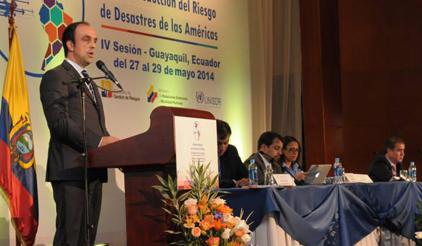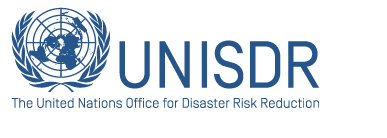 |
|
| |
STRENGTHEN ROLE OF LOCAL AUTHORITIES IN DRR
|
 José Corral, mayor Santa Fe, Argentina, sharing his city's experience in combating urban flooding. José Corral, mayor Santa Fe, Argentina, sharing his city's experience in combating urban flooding.
|
|
By Richard Waddington
GUAYAQUIL, 29 May 2014 - A new global framework for disaster risk reduction (DRR) must seek to strengthen the role of local government because the impact of all disasters is local, the 4th Session of the Americas Platform for Disaster Risk Reduction heard on Wednesday.
With urban populations set to continue rising, it is vital that local governments can mount an effective responses to the environmental threats their populations may face. But local government can be weak, financially strapped and overburdened with conflicting demands.
“It is the local authorities that need to react and everything needs to be done to help them provide effect prevention and response,” Jonas Donizete, Mayor of the Brazilian city of Campinas, told the conference
|
Mayors from four South American cities shared their experiences in developing policies to manage the risks to their communities posed by the environment, which for most of them involved the threat of flooding.
In the Dominican Republic, it was the experience of floods in 2002 that convinced the central government to get local authorities more involved in disaster preparation and response, Aura Saldaña, Mayor of Sabana del Mar, told the conference. “Local action is key to effective disaster prevention and resilience. Local urban and rural communities need to have the capacity to respond to the challenges,” she said.
Despite some progress, there are still issues in the Dominican Republic surrounding coordination between different levels of government and between the public and private sectors. Globally, there is need for clear and measurable indicators that can be used to assess the level of disaster readiness, she said.
Donizete said that flooding in 2003, in which several thousand people were forced from their homes and six people were killed, prompted the local authorities to strengthen planning for possible natural disasters. Coordination between various arms of local government was strengthened and alliances promoted with the private sector. Disaster simulations are staged regularly and an early warning system and close monitoring of risk areas have been instituted. Officials also work with local communities to create a culture of disaster prevention and readiness, he said.
“I took office facing the problems of mudslides and floods and I left office facing them,” said former Mayor of Cuenca, Ecuador, Paul Granda. But this did not mean that nothing was achieved during his five-year term of office, which ended in May 2014. The city had developed a number of initiatives for disaster management. But natural hazards will continue to threaten, he said. The important thing is to identify the risks, apply preventive measures, create some form of financial insurance and prepare for reconstruction, he added.
The northern Argentine city of Santa Fe, which sits beside two major rivers, has a similar tale of responding to a threat of flooding. José Corral, city mayor, said. Starting in 2008, the city has developed a system of disaster risk management, including better urban planning, infrastructure projects and information campaigns. As a result, when heavy rains came in 2013, only a handful of families needed to be evacuated.
The conference in Guayaquil will help shape a new global framework for disaster risk reduction, which will be adopted at the Third UN World Conference on Disaster Risk Reduction in Sendai, Japan, next March, to replace the existing Hyogo Framework for Action (HFA).
Date:
- 29 May 2014
- Sources:
-
- United Nations Office for Disaster Risk Reduction – Regional Office for the Americas (UNISDR AM)
Related Links
Keywords
- Themes:
- Urban Risk & Planning, Governance, Disaster Risk Management
- Hazards:
- Flood
- Countries:
- Argentina, Brazil, Dominican Republic, Ecuador
- Regions:
- Americas
|
|
|




